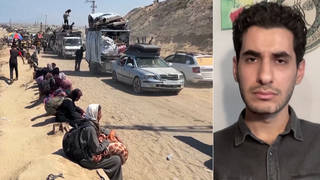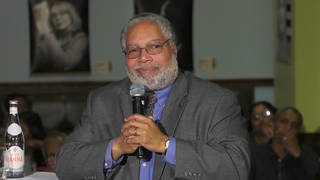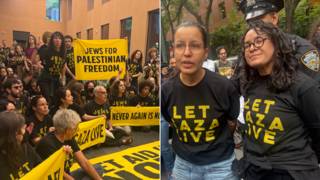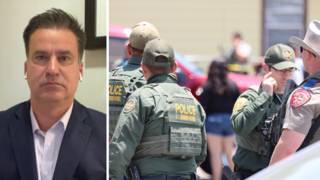
Guests
- Kelly Lytle Hernándezprofessor of history, African American studies and urban planning at UCLA.
We speak with historian Kelly Lytle Hernández, whose new book “Bad Mexicans: Race, Empire, and Revolution in the Borderlands” tells the story of the often-overlooked men and women who incited the Mexican Revolution and how it relates to the rise of U.S. imperialism. The movement included intellectuals, workers and others who opposed Mexico’s dictatorial President Porfirio Díaz, who ruled for decades with support from the U.S. government and U.S. business elites. “What we have is Latinx protagonists at the center of the American story,” says Hernández, who teaches history, African American studies and urban planning at UCLA. “If you want to understand the rise of U.S. empire, you want to understand U.S. immigration history, you want to understand the issues of policing we are confronting today, we have to know that these are Latinx histories.”
Transcript
AMY GOODMAN: This is Democracy Now!, democracynow.org, The War and Peace Report. I’m Amy Goodman, with Juan González.
Here in the United States, many people marked Cinco de Mayo last week, May 5th, a holiday that commemorates Mexico’s unexpected victory over France in the Battle of Puebla, May 5th, 1862, and is now mostly commemorated by Mexican Americans. The hero of that battle was Porfirio Díaz, who went on to rule as the longtime president of Mexico until he was toppled in the Mexican Revolution by people he called “bad Mexicans.” They’re the focus of an incredible new book that explores the untold story of the Mexican Revolution and the men and women who incited it, and how it relates to the rise of U.S. imperialism and white supremacy.
We’re joined right now by Kelly Lytle Hernández, professor of history, African American studies and urban planning at UCLA, author of the new book, just out today, titled Bad Mexicans: Race, Empire, and Revolution in the Borderlands. She’s also the author of the award-winning books Migra! A History of the U.S. Border Patrol and City of Inmates: Conquest, Rebellion, and the Rise of Human Caging in Los Angeles.
Welcome to Democracy Now!, Professor Lytle Hernández. Congratulations on the publication of your book today. You open your book with the story of a lynching. Tell us that story.
KELLY LYTLE HERNÁNDEZ: Sure. Well, first of all, thank you for having me on.
So, this book about a revolution in Mexico actually begins with a lynching in Texas in 1910, when a young man named Antonio Rodríguez was accused of murdering a white woman. And by the end of the day, a posse of white men and farmers and locals had found Antonio and dragged him by a lasso looped around his neck to a tree at the edge of town in Rocksprings, Texas, and they burned him alive. And that story of a lynching was part of a longer history of anti-Mexican violence, especially in Texas but across the borderlands, in which nearly 500 Mexicans were lynched between the 1870s and the 1920s. And all of this racial violence that Mexicans and Mexican Americans were experiencing was part of the uprising that led to the 1910 Mexican Revolution.
JUAN GONZÁLEZ: And, Professor, I’m wondering if you could talk somewhat — your book deals with an important period of history, not only in Mexico but in the United States, as well, which I sometimes refer to as the second conquest of Mexico, the first being the U.S.-Mexican War. But then there was that period in the late 19th century of the invasion of U.S. capital into Mexico during the Porfirio Díaz dictatorship. If you could talk about that and how that actually set up, was the basis for the Mexican Revolution?
KELLY LYTLE HERNÁNDEZ: That’s right. And, Juan, you certainly have been one of the scholars and journalists to help us to understand this.
So, once we have the completion of the transcontinental railroad here in the United States in 1876, major U.S. investors, some of the most famous robber barons, begin looking around and trying to figure out what comes next. And they make a decision. They make a set of agreements with the Porfirio Díaz regime in Mexico to extend U.S. investments into Mexico. And that begins with building a railroad that connects central Mexico to the United States in the 1880s. Following the construction of that railroad, U.S. dollars flood into Mexico and purchase up about 130 million acres of land, nearly a quarter of the Mexican land base, and U.S. investors come to dominate key Mexican industries — railroads, oil, mining and more.
And it’s that invasion of U.S. dollars, also European dollars, that displaces millions of Mexican peasants. Community folks, rural folks, Indigenous populations become displaced, become wage workers. And then they begin to migrate into the United States in search of work. And this is actually the beginning of mass labor migration between Mexico and the United States. So, for us to understand the major demographic shifts that have happened in the 20th century of the United States, which is, in particular, the browning of America, we have to go back to the Porfirio Díaz regime and understand how it operated within the context of the rise of U.S. imperialism in the late 19th century.
JUAN GONZÁLEZ: And you also focus, in your book, on a revolutionary that gets very little — who has gotten very little attention here in the United States, Ricardo Flores Magón, and his brothers, the Magonistas, this incredible group of anarchists who spent so many years here in the U.S. Talk about their role and why you felt it was important to focus on the U.S. government’s collusion with the Mexican government to stamp out revolutionary ideas of Mexicans right here in the U.S.
KELLY LYTLE HERNÁNDEZ: Oh, that’s a great question. So, of course, Ricardo Flores Magón, his brothers and the people who worked with them, the Magonistas, are legendary in Mexico. In fact, the Mexican government declared this year, 2022, to be the year of Ricardo Flores Magón. It’s the centennial of his death in Leavenworth prison in 1922.
And so, who was Ricardo Flores Magón? Ricardo was, in fact, a journalist who had been writing in Mexico City against Porfirio Díaz, called him a dictator, an autocrat, that he had made Mexicans the servants of foreigners. And it was this kind of language, this kind of talk, in a dictatorship, that Porfirio Díaz could not suffer. And so he attempted to suppress the Magonistas, Ricardo Flores Magón and the other journalists in Mexico. He had them arrested numerous times, imprisoned in this horrible prison, Belem Prison in Mexico City, and even issued a gag rule against them and prohibited any newspaper in Mexico from publishing their words. And once that gag rule is issued in 1903, Ricardo Flores Magón and his motley band of journalists cross the border into the United States to continue their writing. They relaunch their newspaper. They actually establish a political party, the Partido Liberal Mexicano, the PLM. And they form an army. And by 1908, this PLM army had raided Mexico four times and really destabilized the Díaz regime.
And it’s that activity, that foment, that social movement that the Magonistas were building, here in the United States and across the borderlands, that brought the Díaz regime together with the United States government to try to stop them from inciting an all-out revolution in Mexico. Now, the U.S. government gets involved because of all those investments by major U.S. investors in Mexico. They wanted to protect those investments. So the U.S. Department of War, Department of Labor, the Immigration Service, the Postal Service, U.S. Marshals and a bevy of spies all get involved in a cross-border counterinsurgency campaign to try to suppress the Magonistas’ uprising. They wanted to extradite, to deport, to imprison or to kidnap as many Magonistas as possible. And Ricardo Flores Magón, in fact, is imprisoned for at least three years in the United States between 1907 and 1910. However, the Magonistas persevered, and they were able to incite the outbreak of the 1910 Mexican Revolution.
AMY GOODMAN: Can you talk about what happened a hundred years ago, Professor Kelly Lytle Hernández, in 1915, El Plan de San Diego, one of the largest and deadliest uprisings against white settler supremacy in the U.S., openly recruiting African Americans and Japanese immigrants to their ranks? And then talk about La Matanza.
KELLY LYTLE HERNÁNDEZ: That’s right. So, the Magonistas’ uprising leads to the outbreak of the 1910 revolution. And then, because Ricardo Flores Magón isn’t really a military leader — he is more of an intellectual, a belligerent — the Magonistas’ campaign begins to decline as the revolution takes off under the leadership of Pancho Villa and Emiliano Zapata and many other people and names that we’re familiar with here in the United States.
However, amidst of the revolution, in 1915, a group of Mexican radicals begin to think about, “Well, we’ve unseated Díaz here, and we’re beginning to pursue a social and economic revolution here in Mexico. Why don’t we also turn north and see what’s possible in terms of unseating white settler supremacy up north?” And so they cross into the United States in the summer of 1915. They recruit African Americans and Japanese immigrants and others into an army for all peoples and liberation of all peoples. And they begin to march across South Texas with the goal of assassinating every white male the age 16 and over. And they do this, and they rip up railroad tracks, and they do kill several people. And that’s El Plan de San Diego. They wanted to end white settler supremacy. And the first lands that they were going to free, they were going to give to African Americans as a sanctuary from white supremacy. The next sets of lands that they were going to liberate, they were going to give to Indigenous populations as a sanctuary from settler supremacy.
However, the blowback against their uprising was extraordinary. And so, after El Plan de San Diego began in the summer of 1915, posses and vigilantes, the U.S. Department of War began to crush the uprising. And people have estimated that anywhere between 300 and even up to 5,000 Mexicans and Mexican Americans were lynched and murdered across South Texas as a repercussion for El Plan de San Diego. Now, scholars call that mass murder of 1915 and 1916 La Matanza, The Massacre.
JUAN GONZÁLEZ: And I’m wondering if you could — your book also deals with the impact of both the migrations during the Porfirio Díaz dictatorship and then, of course, the tens of thousands that left Mexico during the revolution into the United States. The impact of that labor force on the American West, if you could talk about that, as well?
KELLY LYTLE HERNÁNDEZ: Absolutely. So, the revolution itself was — it lasted for seven years, and it was extraordinarily violent, and it pushed about a million Mexicans to become refugees into the United States. And it’s that major transition of the Mexican population into the United States that becomes the foundation for the growth of the Mexican American population for decades and decades to come. You know, across the country today, if you talk to folks who are of Mexican descent, many people will track their family story back to the Mexican Revolution. So that is a major moment in U.S. history, that it transforms our demographics. By 2010, Mexico had become the primary sending place for migrants to the United States, which had replaced European nations as being sort of the font of immigration to the United States. We now have estimates, by 2040, 2045, the United States will be a majority nonwhite population, with Mexicans and Mexican Americans and Latinx folks, in general, in the lead of that major demographic revolution. All of this tracks back to the age of Porfirio Díaz and the Mexican Revolution and the ways in which U.S. empire and revolution shifted a major segment of the Mexican population into the United States.
Now, one important thing to remember here, of course, is that the migration of Mexicans into the United States was not just another immigrant story. This is a story of a nonwhite population that runs headfirst into webs of white supremacy across the United States. And there’s a particular form of white supremacy that’s developed across the southwestern United States that Mexican immigrants confront, and that’s called Juan Crow. Obviously, it’s aligned with Jim Crow occurring throughout the U.S. South but also across the United States. It’s forms of segregation in housing and in schooling. It’s lower wages, more dangerous jobs. It’s an immigration regime that’s beginning to build in the early 20th century that targets people from Mexico, in particular, but nonwhite migrants from south of the border and Asian immigrants, as well. And it’s also, as we talked about before, the extraordinary levels of racial violence that Mexicans and Mexican Americans were confronting here in the United States.
AMY GOODMAN: You talk about the three Rs of U.S. history — race, rebellion and repression — and how — going back to the Mexican Revolution, going back to the Magonistas, how the Magonistas opened a new chapter of policing in the United States. Stopping the uprising was one of the FBI’s first objectives. So, talk about how that uprising led to the surveillance on the border that we see today, in the borderlands, where you, too, grew up.
KELLY LYTLE HERNÁNDEZ: That’s right. Thanks for asking that question.
So, the Magonistas, who had their army, launched several raids into Mexico from Texas. There was a raid in 1906 into Jiménez, Mexico. But there were also three very deadly raids that happened in June of 1908. And those raids resulted in the death of dozens of people and really became news around the world of people beginning to wonder: Can Porfirio Díaz actually suppress this uprising? Are our investments safe in Mexico? And so it destabilized his regime.
And just a couple days after those raids into Mexico, between about June 25th and June 28th of 1908, the United States government, led by Theodore Roosevelt and the U.S. Attorney General Charles Bonaparte, established a new federal police force to enforce national or federal law. And that police force was the Bureau of Investigation. Now, Teddy Roosevelt first imagined the Bureau of Investigation really to go out and to prosecute or arrest folks for violating land law in the American West. But very quickly, after those raids of 1908, they pivot, and they turn the FBI into a counterinsurgency superforce targeting the Magonistas. And so, the FBI, one of its very first big cases is tracking down members of the PLM army and having them arrested and imprisoned across the United States. And there are dozens, if not hundreds, of Magonistas who are imprisoned following the 1908 raids.
So, one of the things that’s really important in the story is that when we think about the rise of the FBI and the rise of policing in 20th century U.S. history, we often don’t think about Mexican Americans in that story or Mexican immigrants in the story. But, in fact, the FBI took some of its first breaths and cut its teeth on policing Mexicans and trying to suppress radical Latinx voices and a social movement that was growing across the borderlands.
JUAN GONZÁLEZ: And we only have about 30 seconds, but the main lesson for today for those reading your book?
KELLY LYTLE HERNÁNDEZ: The main lesson for today is, what we have is Latinx protagonists at the center of the American story, that if you want to understand the rise of U.S. empire, you want to understand U.S. immigration history, if you want to understand the issues of policing that we’re confronting today, we have to know that these are Latinx histories. There are Latinx protagonists at the center of the story. And here is just one example that’s dramatic and cinematic, and I hope that this becomes an entry point for more readers across the United States to open up their lens to understand that Latinx histories are critical, central and pivotal to the U.S. story.
AMY GOODMAN: Kelly Lytle Hernández, we want to thank you so much for being with us, author of the new book, out today, Bad Mexicans: Race, Empire, and Revolution in the Borderlands. She is professor of history, African American studies and urban planning at UCLA. And I really look forward to talking to Juan when his book is republished and updated, Harvest of Empire. I’m Amy Goodman, with Juan González.












Media Options